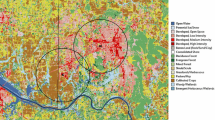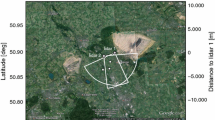High temporal and vertical resolutions of kinematic and thermodynamic characteristics of a late-mature gust front are presented using the Mobile Integrated Profiling System and Weather Surveillance Radar 88 Doppler data. As the gust front passed over the Mobile Integrated Profiling System vertical velocities and the horizontal wind field with 1 and 1.5 min temporal resolutions, respectively, were sampled within the gust front updrafts, gust frontal head and body structures. A 12-channel microwave profiling radiometer was used to delineate the thermodynamic properties with 5–6 min temporal and 100 m vertical resolution. Lidar backscatter from the 0.906 \(\upmu\)m ceilometer was also used to demonstrate the cloud field and the gust front depth. The gust front structurally and dynamically resembled laboratory simulated density current, and was composed of an elevated forward protrusion of a nose, and a turbulent mixing region at the top behind the head. The updrafts associated with the gust front that was moving into a stable layer were not surface rooted. Rather, the updrafts less than 3.5 ms − 1 were observed 500 m above ground level during the gust front passage. These updrafts were present from above the nose level to top of the head. The observations indicated that kinematic and thermodynamic characteristics of the atmospheric boundary layer significantly influenced the propagation speed, updraft characteristics, and overall structural organization of the gust front. The observations validated that observed propagation speed of the gust front was in close agreement with the calculated propagation speed by integrating the buoyancy term within the gust front depth.











Similar content being viewed by others
References
Atkins N T and Wakimoto R M 1997 Influence of the synoptic-scale flow on sea breezes observed during CaPE; Mon. Weather Rev. 125 2112–2130.
Atkins N T, Wakimoto R M and Weckwerth T M 1995 Observations of the sea breeze front during CaPE. Part II: Dual-Doppler and aircraft analysis; Mon. Weather Rev. 123 944–969.
Benjamin T B 1968 Gravity currents and related phenomena; J. Fluid Mech. 31 209–248.
Charba J 1974 Application of gravity current model to analysis of squall-line gust front; Mon. Weather Rev. 102 140–156.
Coleman T A and Knupp K R 2011 Radiometer and profiler analysis of the effects of a bore and a solitary wave on the stability of the nocturnal boundary layer; Mon. Weather Rev. 139 211–223.
Demoz B and Co-authors 2006 The dryline on 22 May 2002 during IHOP_2002: Convective-scale measurements at the profiling site; Mon. Weather Rev. 134 294–310.
Droegemeier K K and Wilhelmson R B 1987 Numerical simulation of thunderstorm outflow dynamics. Part I: Outflow sensitivity experiments and turbulence dynamics; J. Atmos. Sci. 44 1180–1210.
Ecklund W L, Williams C R and Johnston P E 1999 A 3-GHz profiler for precipitation cloud studies; J. Atmos. Ocean. Technol. 16 309–322.
Geerts B, Damiani R and Haimov S 2006 Finescale vertical structure of a cold front as revealed by an airborne Doppler radar; Mon. Weather Rev. 134 251–271.
Guldner J and Spankuch D 2001 Remote sensing of the thermodynamic state of the atmospheric boundary layer by ground-based microwave radiometry; J. Atmos. Ocean. Technol. 18 925–933.
Haertel P T, Johnson R H and Tulich S N 2001 Some simple simulations of thunderstorm outflows; J. Atmos. Sci. 58 504–516.
Hane C E, Rabin R M, Crawford T M, Bluestein H B and Baldwin M E 2002 A case study of severe storm development along a dryline within a synoptically active environment. Part II. Multiple boundaries and convective initiation; Mon. Weather Rev. 130 900–920.
Houze R A Jr 1993 Cloud dynamics; Academic Press, 573p.
Karan H 2007 Thermodynamic and kinematic characteristics of low-level convergent zones observed by the mobile integrated profiling system; Ph.D. Dissertation, University of Alabama, Huntsville.
Karan H and Knupp K R 2006 Mobile integrated profiler system (MIPS) observations of low-level convergent boundaries during IHOP; Mon. Weather Rev. 134 92–112.
Karan H and Knupp K R 2009 Radar and profiler analysis of colliding boundaries: A case study; Mon. Weather Rev. 137 2203–2222.
Kingsmill D E and Crook N A 2003 An observational study of atmospheric bore formation from colliding density currents; Mon. Weather Rev. 131 2985–3002.
Knupp R K 2006 Observational analysis of a gust front to bore to solitary wave transition within an evolving nocturnal boundary layer; J. Atmos. Sci. 63 2016–2035.
Martner B E 1997 Vertical velocities in a thunderstorm gust front and outflow; J. Appl. Meteor. 36 615–622.
May P T 1999 Thermodynamic and vertical velocity structure of two gust fronts observed with a wind profiler/RASS during MCTEX; Mon. Weather Rev. 127 1796–1807.
Miao Q and Geerts B 2007 Finescale vertical structure and dynamics of some dryline boundaries observed in IHOP; Mon. Weather Rev. 135 4161–4184.
Mueller C K and Carbone R E 1987 Dynamics of a thunderstorm outflow; J. Atmos. Sci. 44 1879–1898.
Rasmussen E N, Richardon S, Straka J M, Markowski P M and Blanchard D O 2000 The association of significant tornadoes with a baroclinic boundary on 2 June 1995; Mon. Weather Rev. 128 174–191.
Rotunno R J, Klemp J and Weisman M L 1988 A theory for strong, long-lived squall lines; J. Atmos. Sci. 45 463–485.
Schroeder J A 1990 A comparison of temperature soundings obtained from simultaneous radiometric, radio-acoustic, and rawinsonde measurements; J. Atmos. Ocean. Technol. 7 495–503.
Simpson J E 1969 A comparison between laboratory and atmospheric density currents; Quart. J. Roy. Meteor. Soc. 95 758–765.
Simpson J E 1997 Gravity currents in the environment and the laboratory; 2nd edn, Cambridge University Press, 244p.
Simpson J E and Britter R E 1980 A laboratory model of an atmospheric mesofront; Quart. J. Roy. Meteor. Soc. 106 485–500.
Sipprell B D and Geerts B 2007 Finescale vertical structure and evolution of a preconvective dryline on 19 June 2002; Mon. Weather Rev. 135 2111–2134.
Solheim F, Godwin J R, Westwater E R, Han Y, Keihm S J, Marsh K and Ware R 1998 Radiometric profiling of temperature, water vapor and cloud liquid water using various inversion methods; Radio Sci. 33 393– 404.
Wakimoto R M 1982 The life cycle of thunderstorm gust fronts as viewed with Doppler radar and rawinsonde data; Mon. Weather Rev. 110 1060–1082.
Wakimoto R M and Atkins N T 1994 Observations of the sea-breeze front during CaPE. Part I: Single Doppler, satellite, and cloud photogrammetry analysis; Mon. Weather Rev. 122 1092–1114.
Weckwerth T M and Wakimoto R M 1992 The initiation and organization of convective cells atop a cold-air outflow boundary; Mon. Weather Rev. 120 2169–2187.
Weckwerth T M and Parsons D B 2006 A review of convection initiation and motivation for IHOP_2002; Mon. Weather Rev. 134 5–22.
Weckwerth T M, Parsons D B, Koch S E, Moore J A, LeMone M A, Demoz B B, Flamant C, Geerts B, Wang J and Feltz W F 2004 An overview of the international H2O project (IHOP_2002) and some preliminary highlights; Bull. Am. Meteor. Soc. 85 253–277.
Weisman L M and Klemp J B 1982 The dependence of numerically simulated convective storms on vertical wind shear and buoyancy; Mon. Weather Rev. 110 504–520.
Weisman L M and Rotunno R 2004 A theory for strong long-lived squall lines, revisited; J. Atmos. Sci. 61 361–382.
Weisman L M, Klemp J B and Rotunno R 1988 Structure and evolution of numerically simulated squall lines; J. Atmos. Sci. 45 1990–2013.
Weiss C C and Bluestein H B 2002 Airborne pseudo-Doppler analysis of a dryline-outflow boundary intersection; Mon. Weather Rev. 130 1207–1226.
Wilson J W and Schreiber W E 1986 Initiation of convective storms at radar-observed boundary-layer convergence lines; Mon. Weather Rev. 114 2516–2536.
Wilson J W and Megenhardt D L 1997 Thunderstorm initiation, organization, and lifetime associated with Florida boundary layer convergence lines; Mon. Weather Rev. 125 1507–1525.
Xu Q 1992 Density currents in shear flows – A two-fluid model; J. Atmos. Sci. 49 511–524.
Ziegler C L and Rasmussen E N 1998 The initiation of moist convection at the dryline: Forecasting issues from a case study perspective; Wea. Forecast. 13 1106–1131.
Acknowledgements
Sincere thanks to Dr Kevin R Knupp at UAH for his invaluable scientific contributions to make this work complete. This research was supported by the National Science Foundation under grants ATM-0239889 and ATM-0533596.
Author information
Authors and Affiliations
Corresponding author
Rights and permissions
About this article
Cite this article
KARAN, H. Wind and thermodynamic profiler observations of a late-mature gust front. J Earth Syst Sci 123, 161–175 (2014). https://doi.org/10.1007/s12040-013-0382-z
Received:
Revised:
Accepted:
Published:
Issue Date:
DOI: https://doi.org/10.1007/s12040-013-0382-z




